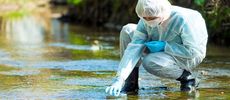The Wide Spectrum of Water Services in Europe


Diverse and far-reaching could be the operative words for European water services. Although governed by one primary regulation—the European Union (EU) Water Framework Directive (WFD)—the sector's size and complexity mean a wide range of countries, governments, companies, associations, and people all play a part.
With such a broad scope, the sector needs harmonized environmental regulations to manage water bodies that border or flow across several EU member states—like the Danube River, which runs through 10 countries. Smart technologies and advanced solutions help EU utilities and labs deal with myriad cross-border issues efficiently and effectively. An increasing emphasis on innovation and sustainability, along with renewable energy to power operations, also characterize the sector.
Let's take a closer look at how water utilities and labs are impacted by this diversity.
Varied and Complex Water Services
EU water services support nearly 450 million people in 27 countries, according to Water News Europe. The sector is large and complex, with many different stakeholders—from regional and national governments to research institutes and trade associations. In 2019, more than 1.5 million people worked in 77,000 EU water supply, sewage, waste management, and remediation businesses. These organizations range from public to private to hybrid services.
The EU also has numerous associations that cover water—including the European Environment Agency, Water Europe, European Water Association, International Commission for the Protection of the Danube River, EurEau, and Aqua Publica Europea. Each represents specific interests or are companies with focuses on everything from healthy ecosystems to irrigation to European rivers.
Cascading European Water Directives
Although the WFD remains the cornerstone for regulations, individual countries must enact their own legislation that, at a minimum, meets the standards set out in the EU directives. And, businesses working in the sector need to look to their home country to make sure they comply. Some of the main directives include:
- Water Framework Directive: The WFD focuses on ensuring good qualitative and quantitative health for Europe's rivers, lakes, and groundwater—including reducing and removing pollution and ensuring adequate water for humans and wildlife.
- Groundwater Directive: The Groundwater Directive sets groundwater quality standards and introduces measures to prevent or limit pollutants and overpumping. The directive also establishes quality criteria, allowing for further improvements to be made based on monitoring data and new scientific knowledge.
- Drinking Water Directive: This directive protects human health thanks to updated water quality standards and addresses pollutants of concern—such as endocrine disruptors and microplastics—hopefully leading to healthier water.
- Bathing Water Directive: The Bathing Water Directive specifies the classification of recreational water—excellent, good, sufficient, or poor—depending on levels of fecal bacteria detected. If water quality is poor, local governments issue swimming bans, provide public information, and take corrective actions.
- Floods Directive: This directive aims to manage the risks floods pose to human health, the environment, the economy, and cultural heritage. Individual countries draft flood risk management plans based on flood hazard maps that cover flood-prone areas and flood risk maps that show potential adverse consequences.
- Water Reuse Directive: This directive enacts regulations that encourage reusing water for agricultural irrigation by establishing minimum requirements.
- Urban Wastewater Treatment Directive: The Urban Wastewater Treatment Directive sets requirements for discharge from urban wastewater treatment plants to sensitive areas. However, the European Commission may require stricter rules and tertiary treatment.
Considerations for Water Labs
The organization of EU water services varies from country to country depending on history, culture, and national or local traditions, according to EurEau's document on the governance of water services in Europe.
Water utilities and labs operating in the EU must be aware of the regulations relevant to their jurisdictions and be able to align with national and regional interpretations. Labs may face technical hurdles, like the need for equipment that can handle the exact tests and procedures they're required to perform.
Lab staff must have the required qualifications to analyze samples and other tests. They need training on the proper way to carry out analytical tasks, especially if they're handling similar tests for more than one locale. As always, labs must follow protocols precisely for transporting and storing samples.
A lab information management system (LIMS) can help meet these challenges by monitoring, reporting, and managing data for labs. Quality control elements lower the risk of noncompliance, and workflow management can keep testing on track during the busiest times anywhere in the world.






